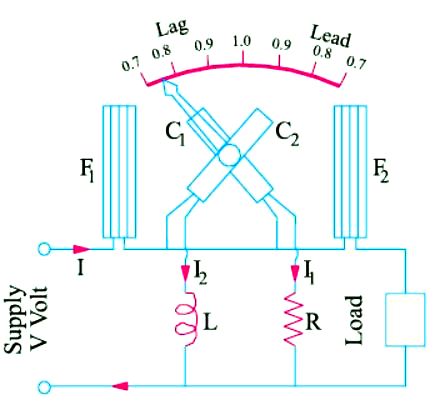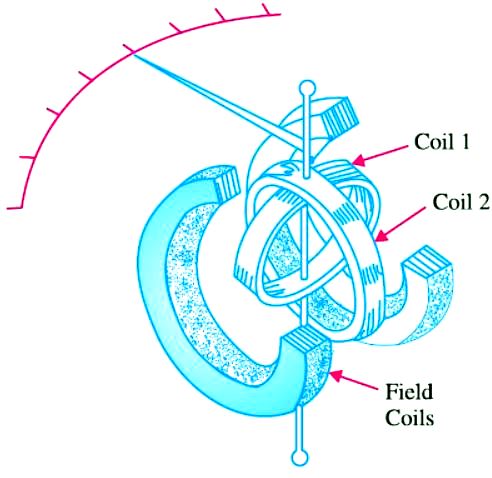Electrodynamic Power Factor Meter
Working Principle of Electrodynamic Power Factor Meter
The Electrodynamic Power Factor Meter is based on the dynamometer principle with spring control removed.

Construction of Electrodynamic Power Factor Meter
As shown in Figure A and Figure B, the instrument has a stationary coil which is divided into two sections F1 and F2. Being connected in series with the supply line, it carries the load current. Obviously, the uniform field produced by F1 and F2 is proportional to the line current. In this field are situated two moving coils C1 and C2 rigidly attached to each other and mounted on the same shaft or spindle. The two moving coils are ‘voltage’ coils but C1 has a series resistance R whereas C2 has a series inductance L. The values of R and L as well as turns on C1 and C2 are so adjusted that the ampere-turns of C1 and C2 are exactly equal. However, I1 is in phase with the supply voltage V whereas I2 lags behind V by nearly 90º. As mentioned earlier, there is no control torque acting on C1 and C2 – the currents being led into them by fine ligaments which exerts no control torque.
AdBlock-2

Working of Electrodynamic Power Factor Meter
Consider the case when load power factor is unity i.e. I is in phase with V. Then I1 is in phase with I whereas I2 lags behind by 90°. Consequently, a torque will act on C1 which will set its plane perpendicular to the common magnetic axis of coils F1 and F2 i.e. corresponding to the pointer position of unity p.f. However, there will be no torque acting on coil C2.
Now, consider the case when load power factor is zero i.e. I lags behind V by 90° (like current I2). In that case, I2 will be in phase with I where as I1 will be 90° out of phase. As a result, there will be no toruqe on C1 but that acting on C2 will bring its plane perpendicular to the common magnetic axis of F1 and F2. For intermediate values of power factor, the deflection of the pointer corresponds to the load power factor angle φ or to cos φ , if the instrument has been calibrated to read to power factor directly.
For reliable readings, the instrument has to be calibrated at the frequency of the supply on which it is to be used. At any other frequency (or when harmonics are present), the reactance of L will change so that the magnitude and phase of current through C2 will be incorrect and that will lead to serious errors in the instrument readings.

For use on balanced 3-phase load, the instrument is modified, so as to have C1 and C2 at 120° to each other, instead of 90°, as in 1-phase supply. As shown in Figure (C), C1 and C2 are connected across two different phase of the supply circuit, the stationary coils F1 and F2 being connected in series with the third phase (so that it carries the line current). Since there is no need of phase splitting between the currents of C1 and C2, I1 and I2 are not determined by the phase-splitting circuit and consequently, the instrument is not affected by variations in frequency or waveform.
Read article – dynamometer
Visit NCERTplanet.com for NCERT solutions and Textbook downloads




